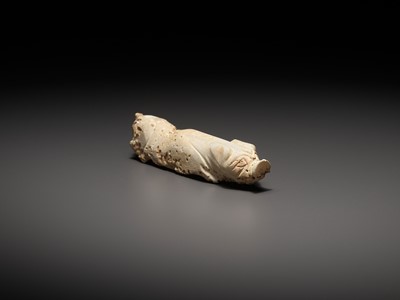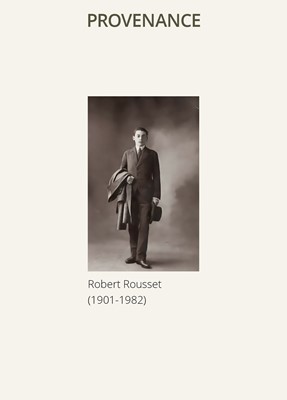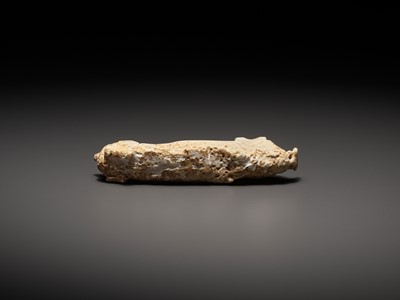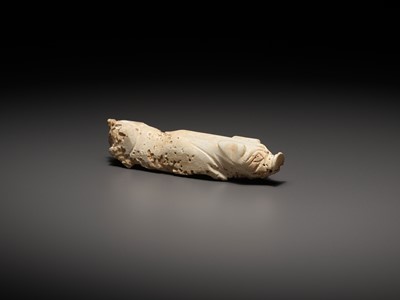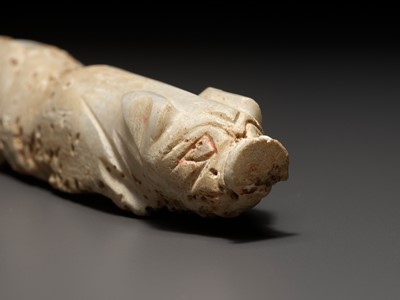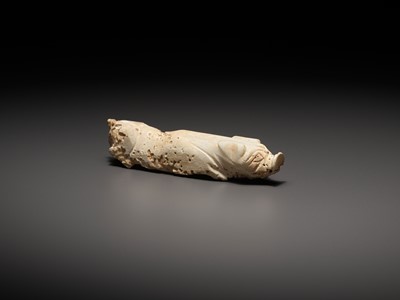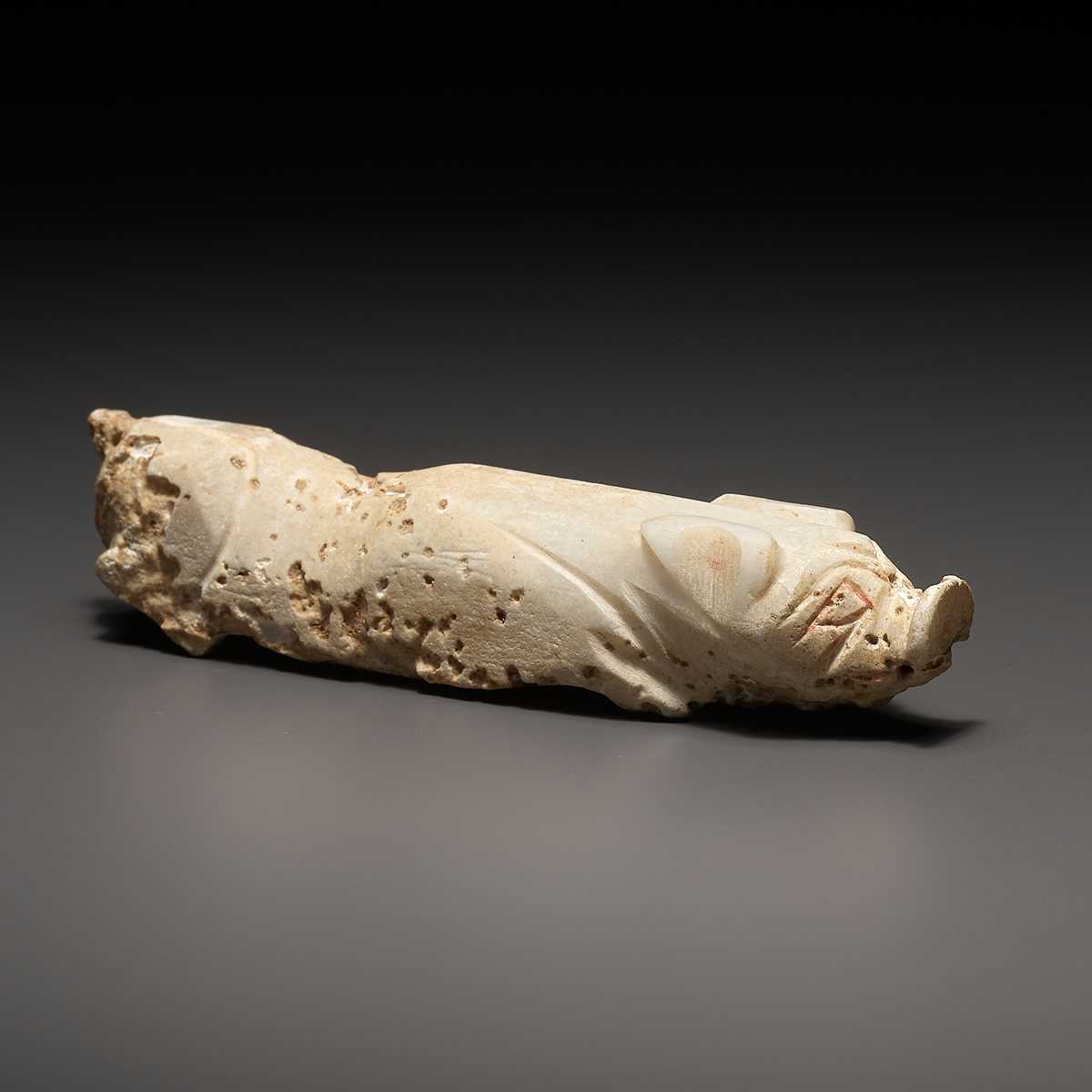1st Mar, 2024 10:00
The No Reserve Dragon Sale
75
A WHITE JADE FIGURE OF A PIG, HAN DYNASTY
漢代白玉豬
Sold for €910
including Buyer's Premium
Please note this Lot is to be sold at No Reserve. 本拍品不設底價
China, 206 BC to 220 AD. Of elongated form, finely carved, detailing the recumbent pig with ears tucked back, a prominent snout, incised brows, and incised eyes outlined in red pigment. The opaque jade once of superb and pure color, now covered almost entirely in calcification, with several distinct areas of erosion.
Expert’s note: Studying a well-documented ancient jade figure, with a bulletproof provenance such as the present lot, can be quite fascinating, especially when it exhibits distinct regions of natural erosion while also retaining some parts of the original jade in pristine condition, all within the same artifact. In the past, esteemed Chinese collectors of archaic jades used to keep multiple such study pieces as references.
Provenance: The personal collection of Robert Rousset, acquired before 1935. Thence by descent to Jean-Pierre Rousset. Robert Rousset was a former French radio officer in the merchant navy, who became one of the most prominent pioneers of the Chinese art market in Paris. As a child, his father, an insurance agent, would take him to Hôtel Drouot where he started to buy at a very young age. His true passion for Asian art started in the 1920s, when he was sent on a mission to Beijing after the decline of the Qing empire, along with Osvald Sirén, the famous Swedish Asian art historian and connoisseur. He then became one of the main contributors of Chinese antiques for the Compagnie de la Chine et des Indes, founded in Paris in the early 20th century by the Blazy brothers. After the 1929 stock market crash, he had the opportunity to acquire the company. With his sister Suzanne in charge of the porcelain, they developed the business and became one of the most important dealers in France, selling pieces to the greatest museums, including the Musée Guimet and the Metropolitan Museum of Art.
Condition: Some old wear, signs of weathering and erosion with associated losses, encrustations, few minor chips, all as can be expected from a jade with 2,000 years of age.
Weight: 102.8 g
Dimensions: Length 11.5 cm
Please click here to read the full description
The present jade carving, with its curved bodyline and shaped snout and tail, is more realistically represented than most jade pigs from the Han dynasty. A very similar jade pig dating to the late Eastern Han dynasty was unearthed from Tomb no. 1 in Dongyuancun in Haoxian, Anhui province, illustrated in Zhongguo meishu quanji, vol. 9, Jade, Beijing, 1986, pl. 195 (fig. 1). It was believed that jade pigs were placed for protection of the dead. This practice is connected with the Daoist belief, as stated in the 4th century text Baopuzi by Ge Hong, 'when gold and jade plug the nine orifices, man dies but his body does not decay'. Pairs of jade pigs were placed in the hands of the deceased. Funerary jade pigs from this period are often carved with a few deep calculated cuts, known as the Eight Cuts of Han.
Literature comparison:
Compare similarly carved jade pigs, Han dynasty, illustrated in the Compendium of Collections in the Palace Museum: Jade 4, Beijing, 2011, p.130, nos.152-153.
Auction result comparison:
Type: Closely related
Auction: Sotheby’s Hong Kong, 8 April 2023, lot 3842
Price: HKD 609,600 or approx. EUR 70,500 converted at the time of writing
Description: A calcified jade recumbent pig, Western Han dynasty
Expert remark: Compare the closely related manner of carving, calcification, and size (11.9 cm).
点此阅读中文翻译 (Chinese Translation)
漢代白玉豬
中國,西元前 206至西元220年。造型細長,豬呈臥姿,耳朵向後收,鼻子突出,眼睛用紅色顏料勾勒出輪廓。 不透明的玉石現在幾乎完全鈣化,有幾個明顯的侵蝕區域。
專家注釋:一個有據可查的古代玉像,具有本拍品這樣的來源,表現出明顯的自然侵蝕區域,同時還保留了原始狀態。人工製品。中國古代玉器收藏家常常保存多件此類研究作品作為參考。
來源:Rousset (1901-1982) 收藏,1935年之前購得,保存至Jean-Pierre Rousset。Robert Rousset曾是商船的無線電通信官。他是法國巴黎的中國藝術市場最傑出的先驅之一。他的父親是一名保險代理人,會帶他去 Hôtel Drouot拍賣行,孩提時代他就開始購買藝術品。他對亞洲藝術的真正熱情始於 1920 年代,當時清朝沒落,他與瑞典著名亞洲藝術史學家和鑑賞家 Osvald Sirén 一起被派往北京。隨後,他成為二十世紀初由 Blazy 兄弟在巴黎創立的 Compagnie de la Chine et des Indes 旗下中國古董的主要合作者之一。1929 年股市崩盤後,他有機會收購了這家公司。在他負責瓷器的妹妹 Suzanne的帶領下,他們發展了這項業務,並成為法國最重要的經銷商之一,向最大的博物館,包括吉美博物館和大都會藝術博物館,出售古董。
品相:磨損、風化、侵蝕跡像、結殼、少量小磕損。
重量:102.8 克
尺寸:長 11.5 厘米
本件玉雕的身體線條彎曲,口鼻尾部形狀各異,比大多數漢代玉豬更為形象。安徽省郝縣東源村1號墓出土了一件與東漢末年極為相似的玉豬,見《中國美術全集》第 9冊《玉》,北京,1986年,圖 195(1)。 人們相信放置玉豬是為了保護死者。 這種做法與道教信仰有關,正如葛洪在四世紀所著的《抱樸子》中所言:“金玉塞九竅,人死而身不朽”。 死者手上放著一對玉豬。 這一時期的陪葬玉豬上常刻有幾道深刻的刻痕,稱為漢八刻。
文獻比較:
比較相似的漢代玉豬,見《故宮博物院藏品大系‧玉器編4》,北京,2011年,頁130,編號152-153。
拍賣結果比較:
形制:非常相近
拍賣:香港蘇富比,2023年4月8日,lot 3842
價格:HKD 609,600(相當於今日EUR 70,500)
描述:西漢雞骨白玻璃光玉握豬
專家評論:比較非常相近的雕刻風格、鈣化和尺寸 (11.9 厘米)。
Please note this Lot is to be sold at No Reserve. 本拍品不設底價
China, 206 BC to 220 AD. Of elongated form, finely carved, detailing the recumbent pig with ears tucked back, a prominent snout, incised brows, and incised eyes outlined in red pigment. The opaque jade once of superb and pure color, now covered almost entirely in calcification, with several distinct areas of erosion.
Expert’s note: Studying a well-documented ancient jade figure, with a bulletproof provenance such as the present lot, can be quite fascinating, especially when it exhibits distinct regions of natural erosion while also retaining some parts of the original jade in pristine condition, all within the same artifact. In the past, esteemed Chinese collectors of archaic jades used to keep multiple such study pieces as references.
Provenance: The personal collection of Robert Rousset, acquired before 1935. Thence by descent to Jean-Pierre Rousset. Robert Rousset was a former French radio officer in the merchant navy, who became one of the most prominent pioneers of the Chinese art market in Paris. As a child, his father, an insurance agent, would take him to Hôtel Drouot where he started to buy at a very young age. His true passion for Asian art started in the 1920s, when he was sent on a mission to Beijing after the decline of the Qing empire, along with Osvald Sirén, the famous Swedish Asian art historian and connoisseur. He then became one of the main contributors of Chinese antiques for the Compagnie de la Chine et des Indes, founded in Paris in the early 20th century by the Blazy brothers. After the 1929 stock market crash, he had the opportunity to acquire the company. With his sister Suzanne in charge of the porcelain, they developed the business and became one of the most important dealers in France, selling pieces to the greatest museums, including the Musée Guimet and the Metropolitan Museum of Art.
Condition: Some old wear, signs of weathering and erosion with associated losses, encrustations, few minor chips, all as can be expected from a jade with 2,000 years of age.
Weight: 102.8 g
Dimensions: Length 11.5 cm
Please click here to read the full description
The present jade carving, with its curved bodyline and shaped snout and tail, is more realistically represented than most jade pigs from the Han dynasty. A very similar jade pig dating to the late Eastern Han dynasty was unearthed from Tomb no. 1 in Dongyuancun in Haoxian, Anhui province, illustrated in Zhongguo meishu quanji, vol. 9, Jade, Beijing, 1986, pl. 195 (fig. 1). It was believed that jade pigs were placed for protection of the dead. This practice is connected with the Daoist belief, as stated in the 4th century text Baopuzi by Ge Hong, 'when gold and jade plug the nine orifices, man dies but his body does not decay'. Pairs of jade pigs were placed in the hands of the deceased. Funerary jade pigs from this period are often carved with a few deep calculated cuts, known as the Eight Cuts of Han.
Literature comparison:
Compare similarly carved jade pigs, Han dynasty, illustrated in the Compendium of Collections in the Palace Museum: Jade 4, Beijing, 2011, p.130, nos.152-153.
Auction result comparison:
Type: Closely related
Auction: Sotheby’s Hong Kong, 8 April 2023, lot 3842
Price: HKD 609,600 or approx. EUR 70,500 converted at the time of writing
Description: A calcified jade recumbent pig, Western Han dynasty
Expert remark: Compare the closely related manner of carving, calcification, and size (11.9 cm).
点此阅读中文翻译 (Chinese Translation)
漢代白玉豬
中國,西元前 206至西元220年。造型細長,豬呈臥姿,耳朵向後收,鼻子突出,眼睛用紅色顏料勾勒出輪廓。 不透明的玉石現在幾乎完全鈣化,有幾個明顯的侵蝕區域。
專家注釋:一個有據可查的古代玉像,具有本拍品這樣的來源,表現出明顯的自然侵蝕區域,同時還保留了原始狀態。人工製品。中國古代玉器收藏家常常保存多件此類研究作品作為參考。
來源:Rousset (1901-1982) 收藏,1935年之前購得,保存至Jean-Pierre Rousset。Robert Rousset曾是商船的無線電通信官。他是法國巴黎的中國藝術市場最傑出的先驅之一。他的父親是一名保險代理人,會帶他去 Hôtel Drouot拍賣行,孩提時代他就開始購買藝術品。他對亞洲藝術的真正熱情始於 1920 年代,當時清朝沒落,他與瑞典著名亞洲藝術史學家和鑑賞家 Osvald Sirén 一起被派往北京。隨後,他成為二十世紀初由 Blazy 兄弟在巴黎創立的 Compagnie de la Chine et des Indes 旗下中國古董的主要合作者之一。1929 年股市崩盤後,他有機會收購了這家公司。在他負責瓷器的妹妹 Suzanne的帶領下,他們發展了這項業務,並成為法國最重要的經銷商之一,向最大的博物館,包括吉美博物館和大都會藝術博物館,出售古董。
品相:磨損、風化、侵蝕跡像、結殼、少量小磕損。
重量:102.8 克
尺寸:長 11.5 厘米
本件玉雕的身體線條彎曲,口鼻尾部形狀各異,比大多數漢代玉豬更為形象。安徽省郝縣東源村1號墓出土了一件與東漢末年極為相似的玉豬,見《中國美術全集》第 9冊《玉》,北京,1986年,圖 195(1)。 人們相信放置玉豬是為了保護死者。 這種做法與道教信仰有關,正如葛洪在四世紀所著的《抱樸子》中所言:“金玉塞九竅,人死而身不朽”。 死者手上放著一對玉豬。 這一時期的陪葬玉豬上常刻有幾道深刻的刻痕,稱為漢八刻。
文獻比較:
比較相似的漢代玉豬,見《故宮博物院藏品大系‧玉器編4》,北京,2011年,頁130,編號152-153。
拍賣結果比較:
形制:非常相近
拍賣:香港蘇富比,2023年4月8日,lot 3842
價格:HKD 609,600(相當於今日EUR 70,500)
描述:西漢雞骨白玻璃光玉握豬
專家評論:比較非常相近的雕刻風格、鈣化和尺寸 (11.9 厘米)。
Zacke Live Online Bidding
Our online bidding platform makes it easier than ever to bid in our auctions! When you bid through our website, you can take advantage of our premium buyer's terms without incurring any additional online bidding surcharges.
To bid live online, you'll need to create an online account. Once your account is created and your identity is verified, you can register to bid in an auction up to 12 hours before the auction begins.
Intended Spend and Bid Limits
When you register to bid in an online auction, you will need to share your intended maximum spending budget for the auction. We will then review your intended spend and set a bid limit for you. Once you have pre-registered for a live online auction, you can see your intended spend and bid limit by going to 'Account Settings' and clicking on 'Live Bidding Registrations'.
Your bid limit will be the maximum amount you can bid during the auction. Your bid limit is for the hammer price and is not affected by the buyer’s premium and VAT. For example, if you have a bid limit of €1,000 and place two winning bids for €300 and €200, then you will only be able to bid €500 for the rest of the auction. If you try to place a bid that is higher than €500, you will not be able to do so.
Online Absentee and Telephone Bids
You can now leave absentee and telephone bids on our website!
Absentee Bidding
Once you've created an account and your identity is verified, you can leave your absentee bid directly on the lot page. We will contact you when your bids have been confirmed.
Telephone Bidding
Once you've created an account and your identity is verified, you can leave telephone bids online. We will contact you when your bids have been confirmed.
Classic Absentee and Telephone Bidding Form
You can still submit absentee and telephone bids by email or fax if you prefer. Simply fill out the Absentee Bidding/Telephone bidding form and return it to us by email at office@zacke.at or by fax at +43 (1) 532 04 52 20. You can download the PDF from our Upcoming Auctions page.
How-To Guides
How to Create Your Personal Zacke Account
How to Register to Bid on Zacke Live
How to Leave Absentee Bids Online
How to Leave Telephone Bids Online
中文版本的操作指南
创建新账号
注册Zacke Live在线直播竞拍(免平台费)
缺席投标和电话投标
Third-Party Bidding
We partner with best-in-class third-party partners to make it easy for you to bid online in the channel of your choice. Please note that if you bid with one of our third-party online partners, then there will be a live bidding surcharge on top of your final purchase price. You can find all of our fees here. Here's a full list of our third-party partners:
- 51 Bid Live
- EpaiLive
- ArtFoxLive
- Invaluable
- LiveAuctioneers
- the-saleroom
- lot-tissimo
- Drouot
Please note that we place different auctions on different platforms. For example, in general, we only place Chinese art auctions on 51 Bid Live.
Bidding in Person
You must register to bid in person and will be assigned a paddle at the auction. Please contact us at office@zacke.at or +43 (1) 532 04 52 for the latest local health and safety guidelines.


